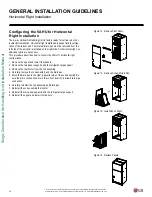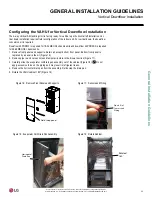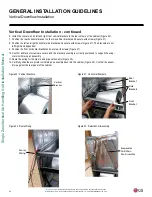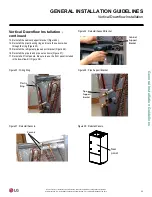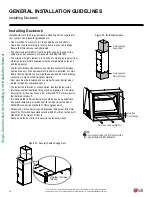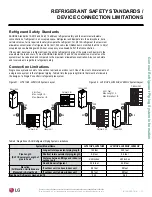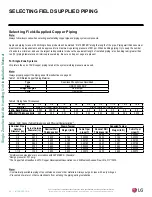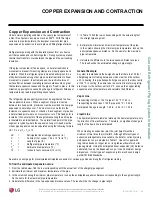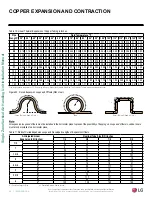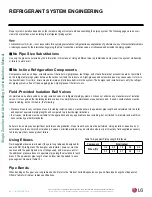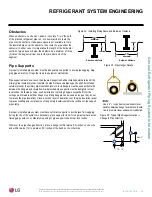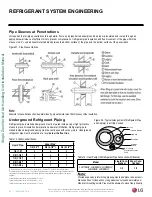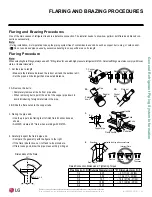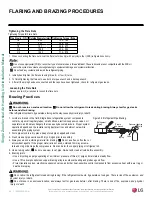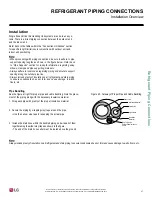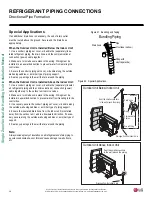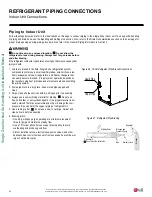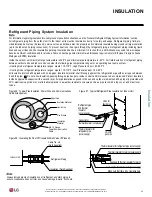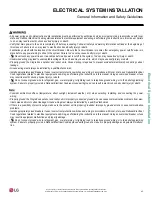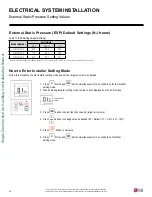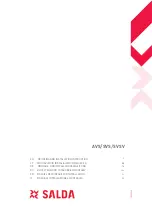
36 | INTRODUCTION
Single Zone V
ertical
Air Handling Unit Installation Manual
Due to our policy of continuous product innovation, some specifications may change without notification.
©
LG Electronics U.S.A., Inc., Englewood Cliffs, NJ. All rights reserved. “LG” is a registered trademark of LG Corp.
13.0 - 18.0
24.6 - 30.4
39.8 - 47.7
Tightening Torque for Flare Nuts.
Tightening the Flare Nuts
1. When connecting the flare nuts, coat the flare (outside only) with
polyvinyl ether (PVE) refrigeration oil only.
2. Initially hand tighten the flare nuts using three (3) or four (4) turns.
3. To finish tightening the flare nuts, use both a torque wrench and a backup wrench.
4. After all the piping has been connected and the caps have been tightened, check for refrigerant gas leaks.
Loosening the Flare Nuts
Always use two (2) wrenches to loosen the flare nuts.
Do not use polyolyester (POE) or any other type of mineral oil as a thread lubricant. These lubricants are not compatible with the PVE oil
used in this system and create oil sludge leading to equipment damage and system malfunction.
Pipe Size (in. O.D.)
Tightening Torque (ft-lbs.)
1/2
1/4
5/8
3/8
3/4
Outside Diameter (mm)
6.35
9.52
12.7
15.88
19.05
45.4 - 59.3
71.5 - 87.5
Do not add any contaminants inside the refrigerant piping.
Figure 39: Refrigerant Pipe Brazing.
Pressure-reducing
Valve
Valve
Taping
Nitrogen
Pipe to
be brazed
Refrigerant
Piping
Brazing Practices
1. Joints are brazed in the field. Single Zone refrigeration system components
contain very small capillary tubes, small orifices, electronic expansion valves, oil
separators, and heat exchangers that can easily become blocked. Proper system
operation depends on the installer using best practices and utmost care while
assembling the piping system.
2. Store pipe stock in a dry place; keep stored pipe capped and clean.
3. Flush clean all pipe sections with dry nitrogen prior to assembly.
4. Always use a non-oxidizing material for brazing.
Do not use flux, soft solder, or
anti-oxidant agents. If the proper material is not used, oxidized film may accumu-
late and clog or damage the compressors. Flux can harm the copper piping or refrigerant oil.
5. Use a tubing cutter,
do not use a saw to cut pipe. De-bur and clean all cuts before assembly.
6. Brazing joints:
• Use a dry nitrogen purge operating at a minimum pressure of three (3) psig and maintain a steady flow.
• Use a 15% silver phosphorous copper brazing alloy to avoid overheating and produce good flow.
• Protect isolation valves, electronic expansion valves, and other heat-sensitive control components from excessive heat with a wet rag or
heat barrier spray.
Do not braze in an enclosed location.
Do not allow the refrigerant to leak during brazing. Always test for gas leaks
before and after brazing.
If the refrigerant combusts, it generates a toxic gas the may cause physical injury or death.
FLARING AND BRAZING PROCEDURES
•
Do not allow the refrigerant to leak during brazing; if the refrigerant combusts, it generates a toxic gas. There is risk of fire, explosion, and
physical injury or death.
•
Do not braze in an enclosed location, and always test for gas leaks before / after brazing. There is risk of fire, explosion, and physical
injury or death.
Summary of Contents for LV181HV4
Page 73: ...NOTES ...

